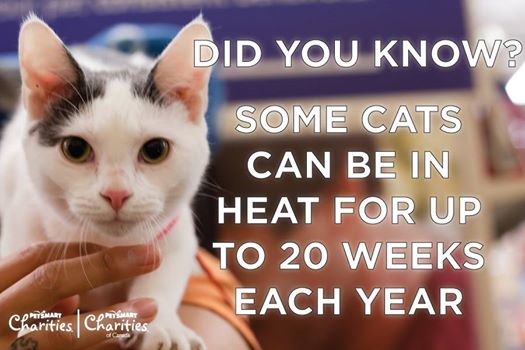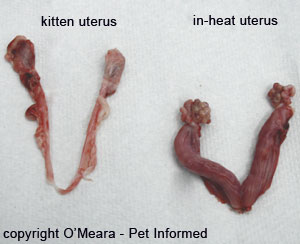New to having a pet or just need more knowledge?
About heat cycles in cats:
Heat, Oestrus, Estrus
All of the above terms are correct in describing female cats' periods of receptiveness to mating, but will be referred to as the more often-used "heat cycles." The breeding season in cats is practically year-round, running as early as February, and as late as December, but in the western hemisphere, March through September is generally regarded as the breeding season.
Rescue people dread "Kitten Season" because it means that in kill shelters, the new crop of kittens will eliminate any chances of adoption for older cats, including last year's kittens. If for no other reason, this alone is ample justification for the spaying and neutering of pet cats. Heat Cycles in Cats are referred to as "polyestrus," which means that they will go into heat cycles periodically during their fertile years. These heat cycles may start as early as the fourth or fifth month of a kitten's life, and will continue until she is either bred or spayed. Heat cycles in cats last from several days to two weeks or longer, and repeat every two to three weeks.
You can see then, how a female cat may almost always seem to be in heat. No one can say with any accuracy that heat cycles are painful to cats; however from the calling (loud yowling) and other symptoms they exhibit, it would appear that they are very uncomfortable. A kitten can have her first heat as early as 4 1/2 months, so don't fall for that old "wait until six months to spay" advice. And remember, that once a female cat has her first heat, it will happen again and again, until she either mates or is spayed.
Heat, Oestrus, Estrus
All of the above terms are correct in describing female cats' periods of receptiveness to mating, but will be referred to as the more often-used "heat cycles." The breeding season in cats is practically year-round, running as early as February, and as late as December, but in the western hemisphere, March through September is generally regarded as the breeding season.
Rescue people dread "Kitten Season" because it means that in kill shelters, the new crop of kittens will eliminate any chances of adoption for older cats, including last year's kittens. If for no other reason, this alone is ample justification for the spaying and neutering of pet cats. Heat Cycles in Cats are referred to as "polyestrus," which means that they will go into heat cycles periodically during their fertile years. These heat cycles may start as early as the fourth or fifth month of a kitten's life, and will continue until she is either bred or spayed. Heat cycles in cats last from several days to two weeks or longer, and repeat every two to three weeks.
You can see then, how a female cat may almost always seem to be in heat. No one can say with any accuracy that heat cycles are painful to cats; however from the calling (loud yowling) and other symptoms they exhibit, it would appear that they are very uncomfortable. A kitten can have her first heat as early as 4 1/2 months, so don't fall for that old "wait until six months to spay" advice. And remember, that once a female cat has her first heat, it will happen again and again, until she either mates or is spayed.
- Heat, oestrus, and estrus all refer to heat cycles in cats.
- The breeding season in cats lasts almost year-round.
- Heat cycles can start as early as four or five months in a female kitten.
- Heat cycles in cats last from several days to two weeks or more
- Heat cycles in cats repeat every two to three weeks until the cat is spayed or becomes pregnant.
- Heat cycles may cause pain or discomfort in cats.
What about Dog heat cycles?
Non-spayed female dogs will go into "heat" or estrus usually twice a year. The age at which they start their cycles and the duration of the cycle varies greatly between the breeds of dogs and individual dogs. Learn more facts about canine estrus in this FAQ.
There are four stages to the canine estrus cycle:
So you could be facing up to 123 days of a TOTAL heat cycle, which breaks down to about 17.5 weeks!
Some general "rules of thumb" for canine estrus:
There are four stages to the canine estrus cycle:
- Proestrus: vaginal discharge, males attracted to females, females unwilling to mate. Length: 4-20 days.
Estrus: swollen vulva, yellowish vaginal discharge, mating occurs during this phase. Length: 5-13 days.
Metestrus (or Diestrus): period after estrus or mating. Length: 60-90 days. If pregnant, pregnancy lasts between 60-64 days in the dog.
Anestrus: period of inactivity (sexual and hormonal) between estrus phases. Length: 2-3 months.
So you could be facing up to 123 days of a TOTAL heat cycle, which breaks down to about 17.5 weeks!
Some general "rules of thumb" for canine estrus:
- The first estrus cycle usually occurs by age 6-12 months; for some small breeds, as early as 5 months, and for some large and giant breeds, the first cycle may not occur until 14 months of age or older.
- On average, dogs have two cycles a year.
- The estrus cycle lasts on average 12-21 days, but maybe be as short as a few days to four weeks. The estrus period length varies widely between breeds and individual dogs.
- The length of a cycle varies widely, even for dogs of the same breed. If in doubt, assume the longer end of the range for the cycle length.
- Bleeding occurs prior to a female being receptive to a male (allowing mounting by the male), but male dogs will be very attracted to the female in the proestrus stage.
- Dogs can get pregnant during their first heat cycle, but this is not advisable as a 6-month old dog is not yet fully grown/mature, and complications for the mother and the puppies are more likely.
|
Contact Us
Adoption Center
270-783-9404 Humane Society
270-842-8572 Clinic*
270-745-8646 Community Cat Hotline
270-715-0937 Fax
270-783-9474 |
Hours of Operation
Monday, Tuesday, Thursday & Friday | 10:00 am - 4:30 pm
Wednesday | CLOSED Saturday | 10:00 am - 4:00 pm Sunday | 12:00 pm - 4:00 pm *Veterinary services are not available every day. Please call ahead to confirm that a Vet is available. Our Vet normally does examinations on animals between 10 a.m. and 2:00 p.m. on Tuesdays and Thursdays. Other services may be available between 10 a.m. and 4 p.m. 1924 Louisville Road
Bowling Green, KY 42101 After-Hours EMERGENCY Line 270-202-9136 |





